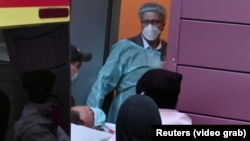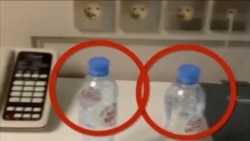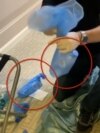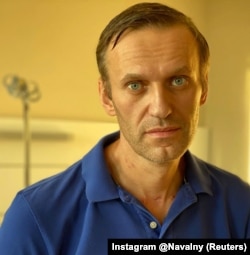A new joint investigation between Bellingcat and several media outlets has revealed evidence they say shows that the recent poisoning of Russian opposition leader Aleksei Navalny was carried out by Russia’s Federal Security Service (FSB).
Citing “voluminous evidence in the form of telecoms and travel data,” the investigation, which included the Insider, a Russian investigative website, and cooperation with Der Spiegel and CNN, showed the August poisoning of the Kremlin critic in the Siberian city of Tomsk appeared to have been in the works since at least early 2017.
“From early 2017 until August 2020, FSB operatives from a clandestine FSB unit specializing in working with poisonous substances shadowed Navalny during his trips across Russia, flew alongside him on more than 30 overlapping flight destinations, and appear to have made at least two attempts to poison him prior to the Tomsk operation,” the group said in a statement on the release of the research on December 14.
Navalny, who is currently in Germany where he is recovering after being poisoned with a Novichok nerve agent in Siberia in late August, said his poisoning case was now solved despite the absence of an official investigation in Russia.
He reiterated his accusation that Russian President Vladimir Putin ordered the poisoning attack on him. The Kremlin has denied any involvement.
Bellingcat, a British-based open-source research group, said the investigation identified three FSB operatives from this clandestine unit who traveled alongside Navalny to Novosibirsk and then followed him to the city of Tomsk where he was ultimately poisoned.
The three were supported and supervised by “at least” five more FSB operatives, some of whom also traveled to Omsk, where Navalny had been hospitalized, it added.
The report names the three as Aleksei Alexandrov, Ivan Osipov -- both medical doctors -- and Vladimir Paniaev. It does not say whether an attempt was made to contact those allegedly involved in the plot.
“Members of the unit communicated with one another throughout the operation, with sudden peaks of communication just before the poisoning as well as during the nighttime hours [Moscow time] when Aleksei Navalny left his hotel and headed to the Tomsk airport,” the investigation said.
Navalny fell ill on the flight to Moscow shortly after takeoff, prompting the crew to make an emergency landing in the city of Omsk where the 44-year-old was hospitalized for days before being flown to Berlin, where doctors concluded that he had been poisoned with a nerve agent.
In a video posted on the Internet on December 14, Navalny said his own investigators had checked the findings of the Bellingcat investigation.
"I know who wanted to kill me. I know where they live. I know where they work. I know their real names. I know their fake names. I have their photos," Navalny said.
"This is a story about a secret group of murderers from the FSB that includes doctors and chemists, about how they tried to kill me several times and almost killed my wife once," he said.
The Bellingcat report comes two days after the British-based Times newspaper cited Western intelligence sources as saying that a second attempt to poison Navalny was made just before he was flown to Germany.
Bellingcat said that an analysis of the phone metadata of 12 FSB operatives linked to the Russian Criminalistics Institute shows that the unit of the FSB operates a boutique chemical-weapons poisoning facility that resembles a KGB-run laboratory described by Soviet-era ex-KGB defectors.
WATCH: Navalny's Team Say He Was Poisoned In Hotel Room, Not At Airport
The FSB is the successor of the KGB, the notorious Soviet-era secret police force that ceased operating in 1991 during the breakup of the Soviet Union.
“By analyzing call metadata, overlapping flight records, and previously leaked offline databases, we have identified at least fifteen operatives who work within this clandestine poisoning sub-unit of the FSB Criminalistics Institute. At least eight of these -- including their supervisor [Stanislav] Makshakov -- had direct involvement in various stages of what appears to have been multiple attempts to poison Alexey Navalny,” the report says.
The so-called “poison squad” members shadowed Navalny since at least January 16, 2017, Bellingcat said, just a month after he announced his plans to run in a 2018 presidential election.
Often traveling under aliases -- sometimes even using one name when heading to a destination, and another name on the way back -- the squad flew on parallel flights to cloak their movements.
“Such a modus operandi would be in keeping with professional operational security practices to minimize chances of Navalny or his team members noticing the same co-passengers on various flights,” the report said, noting there were 37 trips by members of the group to the same destinations that Navalny traveled to.
“Similarly, this consistently applied method would likely make it implausible that this squad was tasked with simply tailing and surveilling Navalny, as such a goal -- in addition to not requiring officers trained in medicine and chemical weapons use -- would conceivably be better achieved by a larger number of different FSB officers flying on the same flight as him,” it added.
The European Union and Britain have imposed asset freezes and travel bans against six senior Russian officials believed to be responsible for the Navalny poisoning, as well as one entity involved in the program that has produced a group of military-grade nerve agents known as Novichok.
The agent used in Navalny’s poisoning appeared similar to the one identified by British authorities as the toxin used in the near-fatal poisoning of Russian double-agent Sergei Skripal and his daughter, Yulia, in 2018 in the English city of Salisbury.














